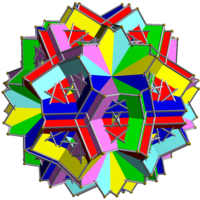Compound of six decagrammic prisms
This uniform polyhedron compound is a symmetric arrangement of 6 decagrammic prisms, aligned with the axes of fivefold rotational symmetry of a dodecahedron.
| Compound of six decagrammic prisms | |
|---|---|
 | |
| Type | Uniform compound |
| Index | UC41 |
| Polyhedra | 6 decagrammic prisms |
| Faces | 12 decagrams, 60 squares |
| Edges | 180 |
| Vertices | 120 |
| Symmetry group | icosahedral (Ih) |
| Subgroup restricting to one constituent | 5-fold antiprismatic (D5d) |
Cartesian coordinates
Cartesian coordinates for the vertices of this compound are all the cyclic permutations of
- (±√(τ/√5), ±2τ−1, ±√(τ−1/√5))
- (±(√(τ/√5)+τ−2), ±1, ±(√(τ−1/√5)−τ−1))
- (±(√(τ/√5)−τ−1), ±τ−2, ±(√(τ−1/√5)+1))
- (±(√(τ/√5)+τ−1), ±τ−2, ±(√(τ−1/√5)−1))
- (±(√(τ/√5)−τ−2), ±1, ±(√(τ−1/√5)+τ−1))
where τ = (1+√5)/2 is the golden ratio (sometimes written φ).
gollark: Ah, well. I don't actually care about any of that except 3 and 5 myself.
gollark: What I listed plus images maybe? I just thought of images.
gollark: What sort of features would *you* want in a chat system?
gollark: Well, except for fiddly stuff like authentication.
gollark: Hey, that might actually be a possible project which I can practically work on.
References
- Skilling, John (1976), "Uniform Compounds of Uniform Polyhedra", Mathematical Proceedings of the Cambridge Philosophical Society, 79 (03): 447–457, doi:10.1017/S0305004100052440, MR 0397554.
This article is issued from Wikipedia. The text is licensed under Creative Commons - Attribution - Sharealike. Additional terms may apply for the media files.